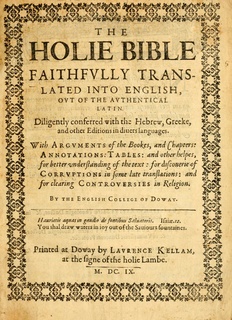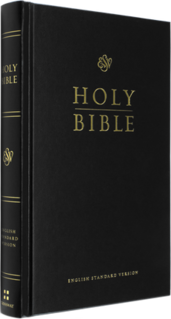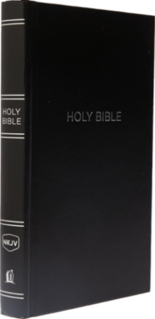
The King James Version (KJV), also the King James Bible (KJB) and the Authorized Version, is an English translation of the Christian Bible for the Church of England, which was commissioned in 1604 and published in 1611, by sponsorship of King James VI and I. The 80 books of the King James Version include 39 books of the Old Testament, an intertestamental section containing 14 books of what Protestants consider the Apocrypha, and the 27 books of the New Testament. Noted for its "majesty of style", the King James Version has been described as one of the most important books in English culture and a driving force in the shaping of the English-speaking world.

The New International Version (NIV) is an English translation of the Bible first published in 1978 by Biblica. The NIV was created as a modern translation, by Bible scholars using the earliest and highest quality source manuscripts available, into broadly understood modern English.

Today's New International Version (TNIV) is an English translation of the Bible which was developed by the Committee on Bible Translation (CBT). The CBT also developed the New International Version (NIV) in the 1970s. The TNIV is based on the NIV. It is explicitly Protestant like its predecessor; the deuterocanonical books are not part of this translation. The TNIV New Testament was published in March 2002. The complete Bible was published in February 2005. The rights to the text are owned by Biblica. Zondervan published the TNIV in North America. Hodder & Stoughton published the TNIV in the UK and European Union.

The Revised Version (RV) or English Revised Version (ERV) of the Bible is a late 19th-century British revision of the King James Version. It was the first and remains the only officially authorised and recognised revision of the King James Version in Great Britain. The work was entrusted to over 50 scholars from various denominations in Great Britain. American scholars were invited to co-operate, by correspondence. Its New Testament was published in 1881, its Old Testament in 1885, and its Apocrypha in 1894. The best known of the translation committee members were Brooke Foss Westcott and Fenton John Anthony Hort; their fiercest critics of that period were John William Burgon and George Saintsbury.

The New Revised Standard Version (NRSV) is an English translation of the Bible published in 1989 by the National Council of Churches. The NRSV was intended as a translation to serve devotional, liturgical and scholarly needs of the broadest possible range of Christian religious adherents. At present, the New Revised Standard Version is the version most commonly preferred by biblical scholars; this is due to its basis on what are often considered the oldest and reliable manuscripts, and its strict adherence to word-for-word translation.

The Douay–Rheims Bible, also known as the Douay–Rheims Version, Rheims–Douai Bible or Douai Bible, and abbreviated as D–R, DRB, and DRV, is a translation of the Bible from the Latin Vulgate into English made by members of the English College, Douai, in the service of the Catholic Church. The New Testament portion was published in Reims, France, in 1582, in one volume with extensive commentary and notes. The Old Testament portion was published in two volumes twenty-seven years later in 1609 and 1610 by the University of Douai. The first volume, covering Genesis through Job, was published in 1609; the second, covering Psalms to 2 Maccabees plus the three apocrypha books of the Vulgate appendix following the Old Testament was published in 1610. Marginal notes took up the bulk of the volumes and had a strong polemical and patristic character. They offered insights on issues of translation, and on the Hebrew and Greek source texts of the Vulgate.

The English Standard Version (ESV) is an English translation of the Bible. The ESV was published in 2001 by Crossway, having been "created by a team of more than 100 leading evangelical scholars and pastors." The ESV relies on recently published critical editions of the original Hebrew and Greek texts.

The New American Standard Bible (NASB) is an English translation of the Christian Bible. Published by the Lockman Foundation, the first NASB text—a translation of the Gospel of John—was released in 1960. The NASB New Testament was released in 1963. The complete NASB Bible was released in 1971. The NASB is a revision of the American Standard Version (ASV).

The New American Bible (NAB) is an English translation of the Bible first published in 1970. The 1986 Revised NAB is the basis of the revised Lectionary, and it is the only translation approved for use at Mass in the Latin-rite Catholic dioceses of the United States and the Philippines, and the 1970 first edition is also an approved Bible translation by the Episcopal Church in the United States.

The New King James Version (NKJV) is an English translation of the Bible. The complete NKJV Bible was published in 1982 by Thomas Nelson, now HarperCollins. The NKJV is described by Thomas Nelson as being "scrupulously faithful to the original, yet truly updated to enhance its clarity and readability."

Modern English Bible translations consists of translations developed and published throughout the late modern period to present-day. A multitude of recent attempts have been made to translate the Bible into English. Most modern translations published since c. 1900 are based on scholarly critical editions of the original Hebrew and Greek texts. Recent translations typically rely on the Biblia Hebraica Stuttgartensia / Biblia Hebraica Quinta, counterparted by the Novum Testamentum Graece.

Wayne A. Grudem is a New Testament scholar turned theologian, seminary professor, and author. He co-founded the Council on Biblical Manhood and Womanhood and served as the general editor of the ESV Study Bible.
Vern Sheridan Poythress is an American philosopher, theologian, New Testament scholar and mathematician, who is currently the New Testament chair of the ESV Oversight Committee. He is also the Professor of New Testament Interpretation at Westminster Theological Seminary and editor of Westminster Theological Journal.
The Holy Bible: Easy-to-Read Version (ERV) is an English translation of the Bible compiled by the World Bible Translation Center. It was originally published as the English Version for the Deaf (EVD) by BakerBooks.
Gender in Bible translation concerns various issues, such as the gender of God and generic antecedents in reference to people. Bruce Metzger states that the English language is so biased towards the male gender that it restricts and obscures the meaning of the original language, which was more gender-inclusive than a literal translation would convey. Wayne Grudem disagrees, believing that a translation should try to match the words of the original language rather than introduce the translator's opinion as to whether the original words meant to include both sexes or not, and that trying to be gender-neutral results in vague and contorted writing style. Michael Marlowe argues from a third standpoint, that the Bible is patriarchal, and gender-neutral language distorts its meaning in an attempt by translators like Metzger to impose their progressive modern views on the text. The topic has theological and political undercurrents. Paul Mankowski says that inclusive-language translators are bowing to feminist political taboos rather than trying to translate accurately, while Marmy Clason says that their opponents are motivated by hostility to feminism rather than fidelity to the original meaning.
The Concordant Version is an English translation of the Bible compiled by the Concordant Publishing Concern (CPC), which was founded by Adolph Ernst Knoch in 1909. The principal works of the CPC are the Concordant Literal New Testament with Keyword Concordance ("CLNT") and the Concordant Version of the Old Testament ("CVOT"). A. E. Knoch designed the Concordant Version in such a way as to put the English reader who lacks a formal knowledge of Koine Greek in possession of all the vital facts of the most ancient codices: Codex Vaticanus, Codex Sinaiticus, and Codex Alexandrinus. The CPC's efforts yielded a restored Greek text, titled The Concordant Greek Text, containing all of the important variant readings found in the codices mentioned above. This was done with the intent of conforming, as far as possible, to the original autograph manuscripts. An utterly consistent hyper-literal sub-linear based upon a standard English equivalent for each Greek element is to be found beneath each Greek word. The Concordant Greek Text forms the basis of the Concordant Literal New Testament, which is more idiomatic in its English than the hyper-literal sublinear. The Concordant Literal New Testament and the Concordant Greek Text are linked together and correlated for the English reader by means of an English concordance—the Keyword Concordance—and a complementary list of the Greek elements.
The Colorado Springs Guidelines is a 1997 document to address gender issues in Bible translation. It was written by theologically conservative Christians in response to "gender-neutral" Bible translations, in particular the New International Version Inclusive Language Edition.

The Sacred Scriptures Bethel Edition (SSBE) is a Sacred Name Bible which uses the names Yahweh and Yahshua in both the Old and New Testaments. It was produced by Jacob O. Meyer, based on the American Standard Version of 1901 and it contains over 977 pages. The Assemblies of Yahweh printed 5,500 copies of the first edition in 1981. It is also used by some members of the Sacred Name Movement.
The Common English Bible (CEB) is an English translation of the Bible whose language is intended to be at a comfortable reading level for the majority of English readers. The translation was begun in late 2008 and was finished in 2011. It includes the deuterocanonical books, or apocrypha, which are found in the Catholic Church and Orthodox Church canons, and in some Anglican Bibles.

The New American Bible Revised Edition (NABRE) is an English-language Catholic translation of the Bible, the first major update in 20 years to the New American Bible (NAB), which was translated by members of the Catholic Biblical Association and originally published in 1970. Released on March 9, 2011, the NABRE consists of the 1986 revision of the NAB New Testament with a fully revised Old Testament approved by the United States Conference of Catholic Bishops in 2010.













